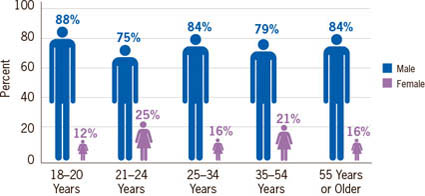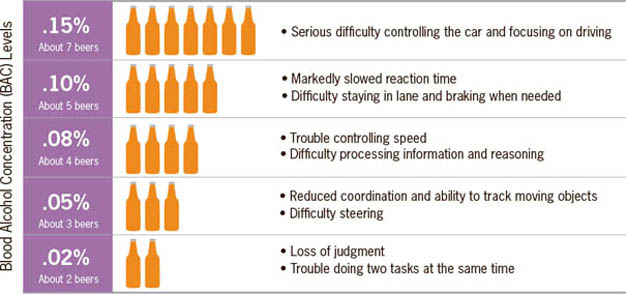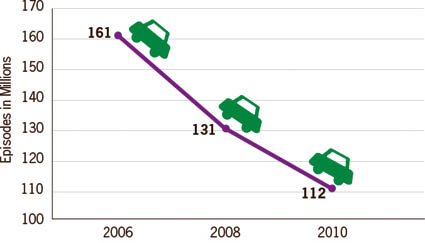- Adults reported drinking and driving about 112 million times in 2010.
- 85% of drinking and driving episodes were reported by binge drinkers.
- Four in 5 people who drink and drive are men.
- Less than 2% of adults report drinking and driving each year, but they put everyone on the road at risk
- 35% of all alcohol-impaired drivers involved in fatal crashes
US adults drank too much and got behind the wheel about 112 million times in 2010. Though episodes of driving after drinking too much (“drinking and driving”) have gone down by 30% during the past 5 years, it remains a serious problem in the US. Alcohol-impaired drivers* are involved in about 1 in 3 crash deaths, resulting in nearly 11,000 deaths in 2009.
Driving drunk is never OK. Choose not to drink and drive and help others do the same.
*These drivers had blood alcohol concentrations of at least 0.08%. This is the illegal blood alcohol concentration level for adult drivers in the United States
Latest Findings
People who drink and drive put everyone on the road in danger
Certain groups are more likely to drink and drive than others.
- Men were responsible for 4 in 5 episodes (81%) of drinking and driving in 2010.
- Young men ages 21-34 made up only 11% of the U.S. adult population in 2010, yet were responsible for 32% of all instances of drinking and driving.
- 85% of drinking and driving episodes were reported by people who also reported binge drinking. Binge drinking means 5 or more drinks for men or 4 or more drinks for women during a short period of time.
There are proven ways to prevent people from drinking and driving.
- At sobriety checkpoints, police stop drivers to judge if they are driving under the influence of alcohol. More widespread, frequent use of these checkpoints could save about 1,500 to 3,000 lives on the road each year.
- Minimum legal drinking age laws prohibit selling alcohol to people under age 21 in all 50 states and the District of Columbia. Keeping and enforcing 21 as the minimum legal drinking age helps keep young, inexperienced drivers from drinking and driving.
- Ignition interlocks prevent drivers who were convicted of alcohol-impaired driving from operating their vehicles if they have been drinking. Interlocks are effective in reducing re-arrest rates from drinking and driving by about two-thirds while the device is on the vehicle.
Your best defense against a drunk driver is to buckle up every time.
- Every person in every seat should be buckled up on every trip. Seat belts reduce serious injuries and deaths from crashes by about 50%.
- Primary enforcement seat belt laws allow police to stop vehicles just because someone is not wearing a seat belt. These state laws are effective in increasing seat belt use.
Who’s At Risk?
Drinking and driving episodes by gender and age, 2010

Some likely effects on driving

Adapted from The ABCs of BAC, National Highway Traffic Safety Administration, 2005, and How to Control Your Drinking, WR Miller and RF Munoz, University of New Mexico, 1982.
Self-reported annual drinking and driving episodes

What Can Be Done
States can:
- Enforce 0.08% blood alcohol concentration and minimum legal drinking age laws.
- Expand the use of sobriety checkpoints.
- Require ignition interlocks for everyone convicted of drinking and driving, starting with their first offense.
- Consider including strategies to reduce binge drinking—such as increasing alcohol taxes—to reduce drinking and driving, since the two behaviors are linked.
- Pass primary enforcement seat belt laws that cover everyone in the car.
Employers can:
- Set policies that immediately take away all work-related driving privileges for any employee cited for drinking and driving while using a company or personal vehicle for work purposes.
- Use workplace health promotion programs to communicate the dangers of drinking and driving, including information directed to family members.
Health professionals can:
- Help patients realize that car crashes are the leading cause of death for everyone ages 5-34 and that 1 in 3 crash deaths involves a drunk driver.
- Routinely screen patients for risky drinking patterns, including binge drinking, and provide a brief intervention—a 10–15 minute counseling session—for patients who screen positive.
Everyone can:
- Choose not to drink and drive and help others do the same.
- Before drinking, designate a nondrinking driver when with a group.
- If out drinking, get a ride home or call a taxi.
- Don’t let friends drink and drive.
- Choose not to binge drink themselves and help others not to do it.
- Talk with a doctor or nurse about drinking and driving and request counseling if drinking is causing health, work, or social problems.
- Buckle up every time, no matter how short the trip. Encourage passengers in the car to buckle up, including those in the back seat.
CDC report shows about 112 million annual incidents of people drinking and driving
Adults drank too much and got behind the wheel about 112 million times in 2010—that is almost 300,000 incidents of drinking and driving each day—according to a CDC Vital Signs (http://www.cdc.gov/vitalsigns/) study released today by the Centers for Disease Control and Prevention.
“The four million adults who drink and drive each year put everyone on the road at risk,” said CDC Director Thomas R. Frieden, M.D., M.P.H. “In fact, nearly 11,000 people are killed every year in crashes that involve an alcohol–impaired driver.”
For the study, CDC analyzed data from the 2010 Behavioral Risk Factor Surveillance System Survey.
The study also found that:
- Men were responsible for 81 percent of drinking and driving in 2010.
- Young men, ages 21–34, made up only 11 percent of the U.S. population in 2010, yet were responsible for 32 percent of all episodes of drinking and driving.
- Eighty–five percent of drinking and driving episodes were reported by people who also reported binge drinking. Binge drinking means five or more drinks for men or four or more drinks for women during a short period of time.
“Drunk driving is a public health problem with far–reaching effects,” said Linda C. Degutis, Dr.P.H., M.S.N., director of CDC’s National Center for Injury Prevention and Control. “Drunk drivers, who have delayed reaction times and reflexes, put even the most responsible drivers and pedestrians in harm’s way. Public support to prevent drunk driving is strong. Thankfully, there are proven ways to protect everyone on the road.”
Proven, effective strategies to prevent alcohol–impaired driving include:
- Sobriety checkpoints: At sobriety checkpoints drivers are stopped to assess their level of alcohol impairment. According to the Transportation Research Board, more widespread, frequent use of these checkpoints could save about 1,500 to 3,000 lives on the road each year.
http://www.thecommunityguide.org/mvoi/AID/sobrietyckpts.html - Minimum legal drinking age laws: These laws prohibit selling alcohol to people under age 21 in all 50 states and the District of Columbia. Keeping 21 as the minimum legal drinking age helps keep young, inexperienced drivers from drinking and driving.
- Ignition interlocks: These devices prevent drivers who were convicted of alcohol–impaired driving from operating their vehicles if they have been drinking. Interlocks are effective in reducing re–arrest rates from drinking and driving by about two–thirds while the device is on the vehicle.
CDC’s Injury Center works to protect the safety of everyone on the roads, every day. For more information about drinking and driving and overall motor vehicle safety, please visit www.cdc.gov/motorvehiclesafety and www.cdc.gov/injury. In addition, a policy issue brief, Policy Impact: Alcohol–Impaired Driving, features more information on state policies to prevent alcohol–impaired driving. For a copy of this data brief, visit www.cdc.gov/motorvehiclesafety/alcoholbrief.
Vital Signs is a CDC report that appears on the first Tuesday of the month as part of the CDC journal Morbidity and Mortality Weekly Report, or MMWR (http://www.cdc.gov/mmwr). The report provides the latest data and information on key health indicators. These are cancer prevention, obesity, tobacco use, motor vehicle passenger safety, prescription drug overdose, HIV/AIDS, alcohol use, health care–associated infections, cardiovascular health, teen pregnancy, asthma, and food safety.
USDOT Warns Drivers: ‘Drive Sober or Get Pulled Over’
- research shows pre-dawn drunk driving crashes claim a life every 23 minutes
The U.S. Department of Transportation (DOT) markes its annual enforcement crackdown and the launch of a nationwide, multi-year advertising campaign aimed at getting drunk drivers off the road: “Drive Sober or Get Pulled Over.” With new research showing fatal crashes involving drunk drivers occur most frequently between the hours of midnight and 3AM—when drunk driving crashes claim a life every 23 minutes—the efforts are particularly focused on nighttime enforcement.
“While we have made great strides in reducing drunk driving over the years, tragically, drunk driving remains one of the leading causes of death and injury on America’s roads,” said U.S. Transportation Secretary Ray LaHood. “Through our new national advertising campaign and stepped up law enforcement actions, we’re sending a powerful message to the American driving public—’Drive Sober or Get Pulled Over.'”
A new analysis by DOT’s National Highway Traffic Safety Administration (NHTSA) shows the highest risk of being involved in a fatal crash with a drunk driver occurs between the hours of midnight and 3AM. Fully two thirds of the fatal crashes during these pre-dawn hours involve drunk drivers. Other key findings include:
- One in four of the nearly 11,000 people killed in a crash involving a drunk driver in 2009 died between the hours of midnight and 3AM.
- One in three drivers aged 21 to 24 years old involved in fatal crashes were alcohol-impaired. Drivers aged 25 to 34 years old were the second most likely to be involved in these types of crashes.
- The next worst times of day with particularly high percentages of alcohol-impaired crashes were 9PM to midnight and 3AM to 6AM.
New advertising released by DOT this month and running in major media markets across the country features “invisible” law enforcement officers observing alcohol-impaired individuals unseen before apprehending them when they attempt to drive their vehicles. The ads convey the message that law enforcement officers are both omnipresent and vigilant in deterring drunk drivers. Coinciding with the advertising push, states are engaged in stepped up enforcement efforts in communities nationwide. The ad theme and slogan will comprise DOT’s core drunk driving message for 2011 – 2016.
“Law enforcement officers across the country are out in force, cracking down on anyone who breaks the law and drives drunk,” said NHTSA Administrator David Strickland. “If you’ve had too much to drink, don’t even think about getting behind the wheel. You may not see them, but they will see you. Don’t risk it.”
Targeting drivers in the final weeks of summer from August 19 through the Labor Day holiday weekend, the annual crackdown is focused on reducing the tragic toll caused by impaired drivers every year. The efforts involve more than 10,000 police departments and other law enforcement agencies across the nation, who will be redoubling their efforts during this high-risk travel period to ensure that impaired drivers are detected and arrested.
“High visibility law enforcement is an important part of MADD’s Campaign to Eliminate Drunk Driving,” said MADD National President Jan Withers. “MADD is proud to partner with NHTSA and the heroes who keep our roads safe to remind the public to Drive Sober or Get Pulled Over.”
